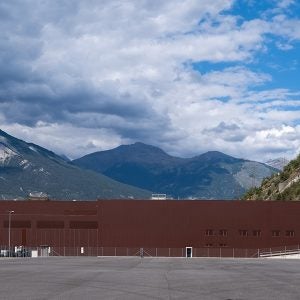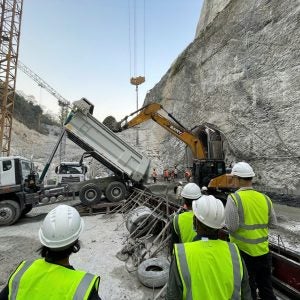The first of three technologically advanced tunnel-boring machines (TBMs) assigned to Snowy 2.0 has been commissioned, marking a major milestone for the Australian renewable energy project.
Assembled onsite after its components were transported from Port Kembla, the ‘Lady Eileen Hudson’ TBM with an 11m diametre will excavate the 2.6km main access tunnel to where a cavern will be dug to house the underground powerhouse of the pumped-storage scheme. The TBM will then be dismantled and reassembled at the Talbingo portal where it will excavate the tailrace tunnel.
The commissioning of the specifically designed TBM was celebrated by Webuild and its partners in the Future Generation joint-venture, together with Snowy Hydro Ltd.
Marco Assorati, Webuild Executive Director Asia Pacific, and Antonio Betti, Future Generation’s Snowy 2.0 Project Director, joined Energy and Emissions Reduction Minister Angus Taylor and Paul Broad, Chief Executive of Snowy Hydro, at the ceremony held at Lobs Hole, the site of the future tunnel where they inspected the TBM.
“This marks the start of an amazing journey together,” said Assorati. “We are proud to be a part of a project that will provide a sustainable future for our children.”
In addition to the combined total of 40km to excavate, the Future Generation joint-venture, which also includes Lane Construction and Australia’s Clough, is overseeing the construction of access roads and other infrastructure like workers’ camps necessary for the development of the project. In the town of Cooma, there is a pre-cast factory and batching plant to produce the concrete segments that will line the tunnel walls.
Set in the Snowy Mountains, Snowy 2.0 will provide 2000MW of fast-start, dispatchable energy and provide 350,000MWh of large-scale storage, enough to power the equivalent of 500,000 homes for over a week during peak demand.
Snowy 2.0 will expand Snowy Hydro’s network of hydro power stations to support the country’s transition to a low-carbon emissions future. About 1,000 people are working on the project, with 150 local businesses involved, and about 4,000 jobs expected to be created during the life of the project. There is also the potential for many more jobs to be created in the region among supply and support services.






